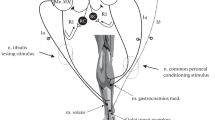Summary
The authors studied changes of the functional state of the peripheral neuromuscular apparatus during elaboration of the spinal cord dominant. The dominant was built up in one of the flexor centers of the frog's hindleg through application of rhythmic subliminal stimuli. The formation of the dominant manifested itself by inversion of the reciprocal relations between the centers of antagonists. It was found that as the dominant appears in a flexor center of the spinal cord in a motor nerve and in the muscle innervated by it in the corresponding limb, rheiobase, chronaxie, the threshold quantity of electricity, and the threshold energy of the stimulating current decrease, with simultaneous increase of all these parameters in the contralateral extremity. Disappearance of the dominant is accompanied by restoration of the initial level of excitability of the nerve and muscle, while the transfer of the dominant from a flexor center in one extremity to the centers of the other extremity leads to corresponding modifications in their excitability.
Similar content being viewed by others
Literature Cited
N. K. Aristova, Influence of Dominant and Inhibitory Centers in the Central Nervous System on the Functional State of the Peripheral Neuromuscular Apparatus. Candidate's Thesis [in Russian] (Leningrad, 1953).
N. K. Aristova, Uchen. Zapiski LGU, Ser. Biol. 222, 106 (1957).
O. V. Verzilova, Byull. Éksp. Biol. Med.45, 2, 12 (1958). Original Russian pagination. See C. B. translation.
I. A. Vetyukov, Transactions, Second All-Union Physiological Congress [in Russian] (Leningrad, 1926) p. 125.
I. A. Vetyukov, Selected Works from Physiological Laboratory, Leningrad State University, in Honor of 25 Years of Scientific Activity of A. A. Ukhtomskii [in Russian] (Moscow-Leningrad, 1930) p. 145.
M. I. Vinogradov, Fiziol. Zhur.6, 47 (1923).
M. I. Vinogradov and G. P. Konradi, Mediko-biol. Zhur.2, 63 (1928).
G. P. Konradi, Selected Works from Physiological Laboratory, Leningrad State University, in Honor of 25 Years of Scientific Activity of A. A. Ukhtomskii [in Russian] (Moscow-Leningrad, 1930) p. 118.
D. M. Nasonov and D. L. Rozental', Fiziol. Zhur.39, 4, 405 (1953).
D. N. Nasonov and D. L. Rozental', Fiziol. Zhur.,41, 1, 121 (1955).
Yu. M. Uflyand, Fiziol. Zhur.,8, 3–4, 132 (1925).
Yu. M. Uflyand, in: New Data in the Reflexology and Physiology of the Nervous System, Collection 1, [in Russian] (Leningrad-Moscow, 1925) p. 80.
A. A. Ukhtomskii, Collected Works [in Russian] (Leningrad, 1950) Vol. 1.
A. A. Ukhtomskii, Uchen. Zapiski LGU22, 35 (1950).
Author information
Authors and Affiliations
Rights and permissions
About this article
Cite this article
Sheikhon, F.D., Nikishin, G.V. Change of the functional state of the peripheral neuromuscular apparatus during the formation of a dominant in the spinal cord. Bull Exp Biol Med 50, 997–1003 (1961). https://doi.org/10.1007/BF00784865
Received:
Issue Date:
DOI: https://doi.org/10.1007/BF00784865



